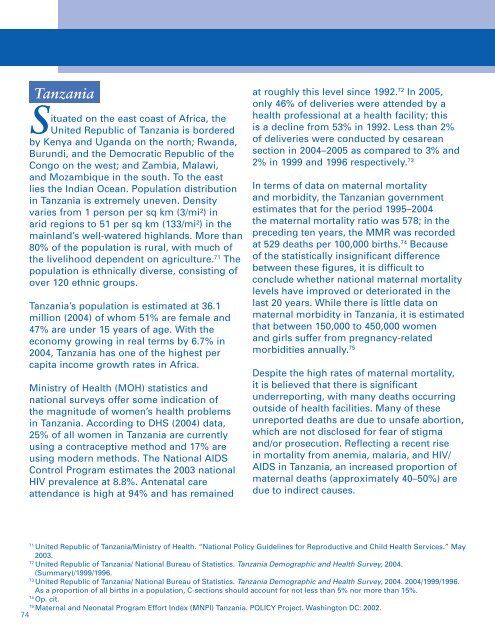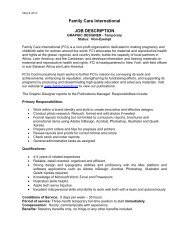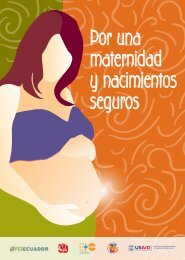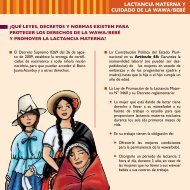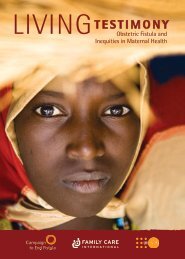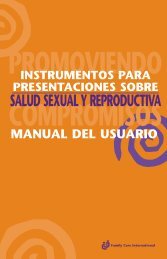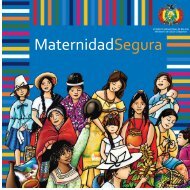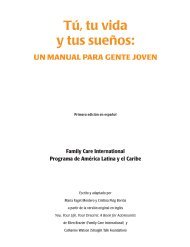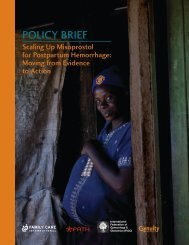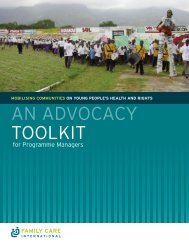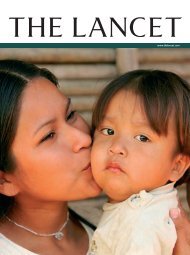Safe Motherhood: A Review - Family Care International
Safe Motherhood: A Review - Family Care International
Safe Motherhood: A Review - Family Care International
Create successful ePaper yourself
Turn your PDF publications into a flip-book with our unique Google optimized e-Paper software.
Tanzania<br />
Situated on the east coast of Africa, the<br />
United Republic of Tanzania is bordered<br />
by Kenya and Uganda on the north; Rwanda,<br />
Burundi, and the Democratic Republic of the<br />
Congo on the west; and Zambia, Malawi,<br />
and Mozambique in the south. To the east<br />
lies the Indian Ocean. Population distribution<br />
in Tanzania is extremely uneven. Density<br />
varies from 1 person per sq km (3/mi²) in<br />
arid regions to 51 per sq km (133/mi²) in the<br />
mainland’s well-watered highlands. More than<br />
80% of the population is rural, with much of<br />
the livelihood dependent on agriculture. 71 The<br />
population is ethnically diverse, consisting of<br />
over 120 ethnic groups.<br />
Tanzania’s population is estimated at 36.1<br />
million (2004) of whom 51% are female and<br />
47% are under 15 years of age. With the<br />
economy growing in real terms by 6.7% in<br />
2004, Tanzania has one of the highest per<br />
capita income growth rates in Africa.<br />
Ministry of Health (MOH) statistics and<br />
national surveys offer some indication of<br />
the magnitude of women’s health problems<br />
in Tanzania. According to DHS (2004) data,<br />
25% of all women in Tanzania are currently<br />
using a contraceptive method and 17% are<br />
using modern methods. The National AIDS<br />
Control Program estimates the 2003 national<br />
HIV prevalence at 8.8%. Antenatal care<br />
attendance is high at 94% and has remained<br />
at roughly this level since 1992. 72 In 2005,<br />
only 46% of deliveries were attended by a<br />
health professional at a health facility; this<br />
is a decline from 53% in 1992. Less than 2%<br />
of deliveries were conducted by cesarean<br />
section in 2004–2005 as compared to 3% and<br />
2% in 1999 and 1996 respectively. 73<br />
In terms of data on maternal mortality<br />
and morbidity, the Tanzanian government<br />
estimates that for the period 1995–2004<br />
the maternal mortality ratio was 578; in the<br />
preceding ten years, the MMR was recorded<br />
at 529 deaths per 100,000 births. 74 Because<br />
of the statistically insignificant difference<br />
between these figures, it is difficult to<br />
conclude whether national maternal mortality<br />
levels have improved or deteriorated in the<br />
last 20 years. While there is little data on<br />
maternal morbidity in Tanzania, it is estimated<br />
that between 150,000 to 450,000 women<br />
and girls suffer from pregnancy-related<br />
morbidities annually. 75<br />
Despite the high rates of maternal mortality,<br />
it is believed that there is significant<br />
underreporting, with many deaths occurring<br />
outside of health facilities. Many of these<br />
unreported deaths are due to unsafe abortion,<br />
which are not disclosed for fear of stigma<br />
and/or prosecution. Reflecting a recent rise<br />
in mortality from anemia, malaria, and HIV/<br />
AIDS in Tanzania, an increased proportion of<br />
maternal deaths (approximately 40–50%) are<br />
due to indirect causes.<br />
71 United Republic of Tanzania/Ministry of Health. “National Policy Guidelines for Reproductive and Child Health Services.” May<br />
2003.<br />
72 United Republic of Tanzania/ National Bureau of Statistics. Tanzania Demographic and Health Survey, 2004.<br />
(Summary)/1999/1996.<br />
73 United Republic of Tanzania/ National Bureau of Statistics. Tanzania Demographic and Health Survey, 2004. 2004/1999/1996.<br />
As a proportion of all births in a population, C-sections should account for not less than 5% nor more than 15%.<br />
74 Op. cit.<br />
75 Maternal and Neonatal Program Effort Index (MNPI) Tanzania. POLICY Project. Washington DC: 2002.


